Emilia Romagna is certainly one of the best-known Italian regions when we talk about good food, which is why many tourists are attracted not only by its artistic and natural beauty, but also by the delicacies that can be enjoyed on the tables of its restaurants.
So if you should come across the inland or coastal areas, you can't miss the chance to taste the tastiest local delicacies: discover our tribute to the 10 Emilia Romagna food specialties - some of them are very famous and some deserve perhaps further visibility.

Tradition is on the table in Emilia Romagna food specialties
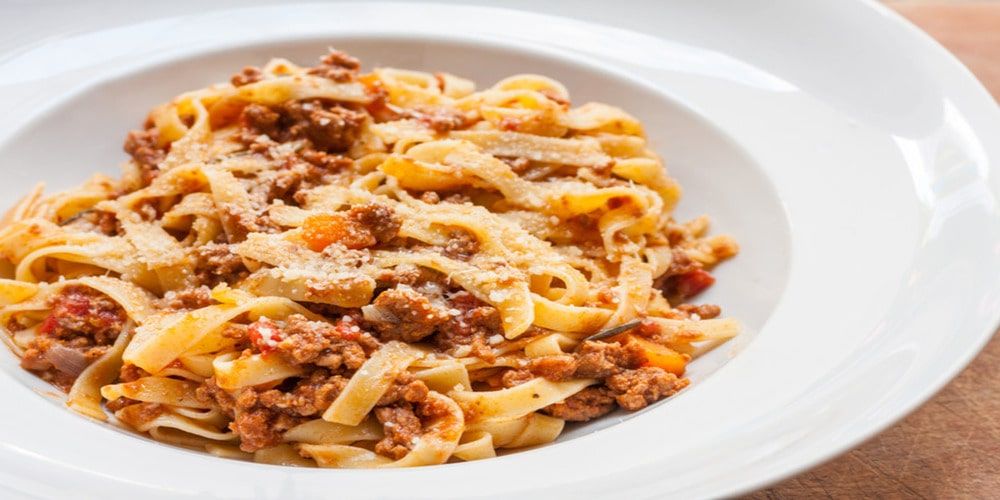
Famous for its production of handmade fresh pasta, Emilia Romagna is the region of the sfogline, the ladies who still roll out egg sheets with their huge rolling pin and make lasagna and tagliatelle to be dressed with the famous ragù, or tortellini, ravioli and other varieties with rich fillings.
But it is also the birthplace of piadina, tigelle, gnocco fritto, to be accompanied by mortadella, prosciutto crudo, culatello, squaquerone, Parmigiano Reggiano. And not forgetting the pastry treasures, such as torta tenerina and zuppa inglese.
It would not be enough a lifetime, in short, to list the typical delicacies of this region, which is not by chance known as Food Valley, a territory where countless typical products are made and consumed.
In this article we would like to offer you a (certainly not exhaustive) overview of the delights of this territory, introducing you to 10 Emilia Romagna food specialties belonging to the different provinces and inviting you to taste them on your next trips.
10. Gnocco fritto (fried gnocco)
The gnocco fritto, fried gnocco, is one of the most beloved typical products of Emilia Romagna cuisine, the recipe for which was apparently handed down to the Emilians by the Lombards during their rule.
It is often used as a substitute for bread and it is a mixture of flour, water, yeast, and lard. As the name implies, it is fried and served with cold cuts and cheese; it reaches its best with mortadella, pickled vegetables and squaquerone and, of course, a good glass of Lambrusco - which is why it is the king of the taglieri (plate of charcuterie) that are eaten as appetizers or during aperitifs.
Small trivia: depending on the province, it takes on a different name, and if "gnocco" is typical of Modena and Reggio Emilia, in Bologna it is called “crescentina,” in Parma “torta fritta” and in Piacenza “chisulèn.”
Learn the secrets of prosciutto crudo productionListen to the podcast version with the voice of Mona Lisa
9. Tortellini

Tortellini are a true classic among the Emilia Romagna food specialties. They're a special type of stuffed egg pasta among the best known in the world. The name tortellino, a shortening of tortello, comes from the word torta, cake, and it is due to their round shape and filling.
It was originally a humble recipe, created to recycle leftover meat from the tables of wealthy gentlemen, and it seems that their shape is inspired by that of a beautiful woman navel; and just like this, it seems that the perfect tortellino must be small in size and that to close the dough flaps must perfectly embrace the circumference of the little finger.
Currently, tortellini fillings are more than in the past and are not limited to meat only. Alongside tortellini, which are generally eaten in broth, we find other types of filled pasta, such as ravioli, cappelletti, and anolini, each of which takes on a different shape and a different filling depending on the province - ricotta and spinach, pumpkin, porcini mushrooms, prosciutto crudo, and parmesan.
8. Piadina romagnola
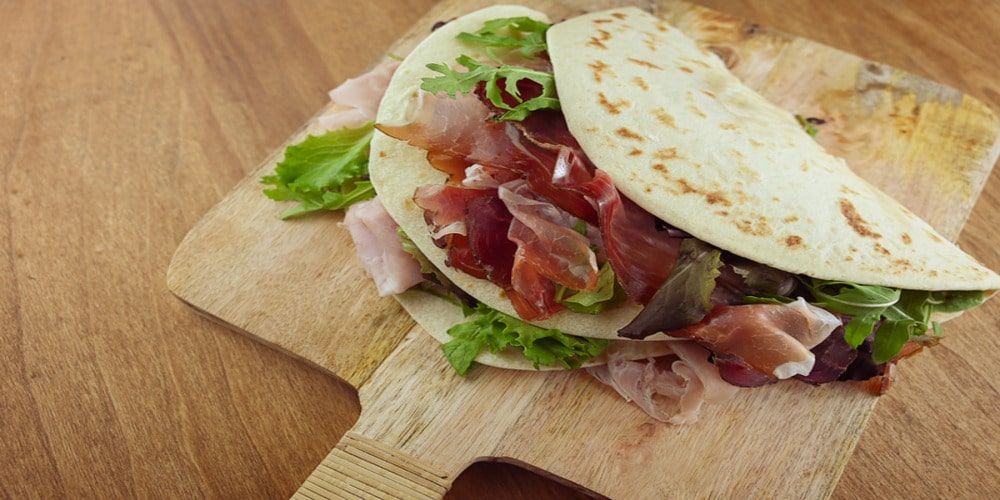
Among the Emilia Romagna specialties, we can't omit the piadina romagnola, the most successful export food from Rimini around the world.
The piadina is a sheet of wheat flour, lard or olive oil, baking soda or yeast, salt and water, which is traditionally cooked on an earthenware dish, called teglia (teggia in Romagnolo). It seems that the thickness of the piadina increases as you move towards the north of Romagna: the variant from Rimini is the thinnest, the one cooked in the Cesena area is of medium height, while towards Ravenna and Forlì it gets thicker.
The piadina, which has a typical half-moon shape, can be stuffed in various ways, depending on taste; in Romagna cuisine, for example, it is prepared with the squacquerone, a fresh soft cheese, arugula and raw ham, but also with cooked ham, mortadella, mozzarella and tomato, and even caramelized figs, as enjoyed in Ravenna.
7. Tigella
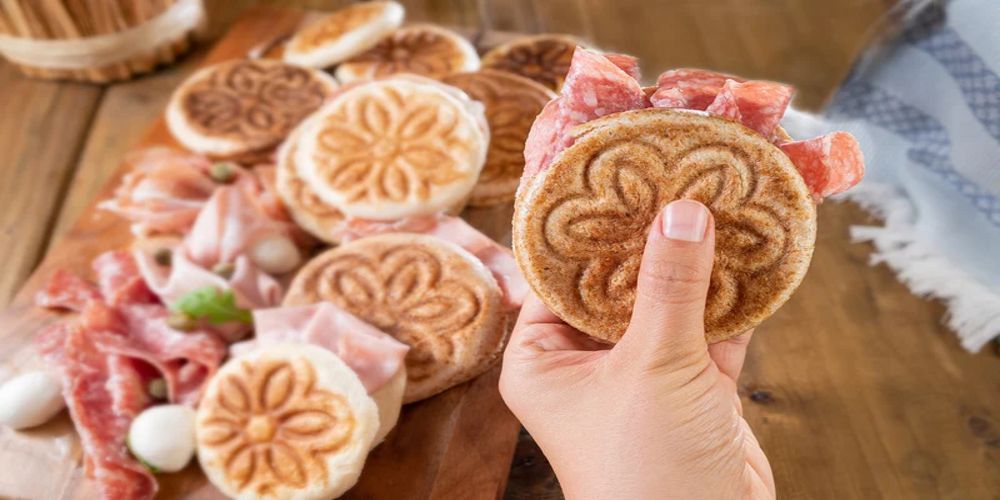
Tigelle are a must among in the Emilia Romagna cuisine, particularly in the province of Modena. They are small leavened flatbreads whose name derives from the refractory earth and clay mold taken from chestnut groves that was once used to bake them (in burning ashes), the tigella indeed.
Tigelle represent the top among appetizers in the cities of Emilia, and like gnocco fritto they are served with your favorite cold cuts and cheeses, or with vegetables and other specialties, although the typical accompaniment is with cunza, or Modenese pesto, a sauce made by mixing lard, rosemary and crushed garlic.
Explore the place where balsamic vinegar is produced6. Tagliatelle and strozzapreti
Emilia Romagna is undoubtedly the region where fresh pasta reaches the top of taste and quality, thanks to the work of the sfogline, who still master a skill that has been handed down from one generation to the next and that gives rise to numerous formats. Among the most beloved non-stuffed pasta we certainly have tagliatelle and strozzapreti.
The former clearly doesn't need to be introduced, but you don't know that their shape was a tribute by Giovanni II di Bentivoglio, lord of Bologna, to Lucrezia Borgia and her beautiful blond hair. They are best enjoyed with classic ragù or with porcini mushrooms and, of course, a generous sprinkling of Parmesan cheese.
The latter are prepared without eggs, but only water and flour, and are a fairly long pasta format that twists on itself; the lack of eggs stems from the bad habit priests had when the region was within the Papal States, which was to steal eggs from the sfogline, who had to make up for this lack-and understandably wished the little thieves in cassocks to choke themselves. Even for strozzapreti, the recommended accompaniment is the classic one, with ragù and Parmesan cheese.
5. Lasagna
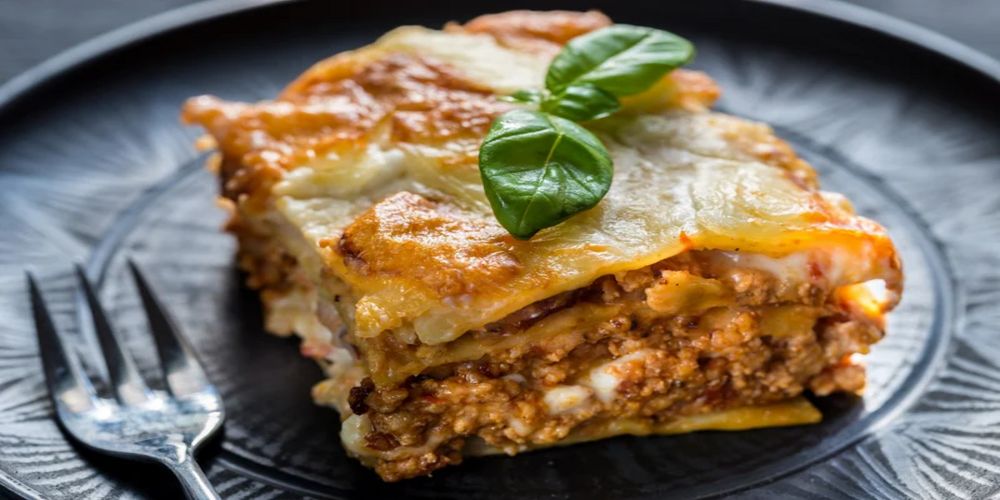
The queen of Italian tables, especially on Sundays and holidays, lasagna is one of the most popular dishes among foreign tourists. Rich and versatile, its original recipe calls for alternating sheets of egg pasta filled with ragù, béchamel sauce and often cheese, but it can be prepared according to taste and preference in a thousand different ways.
Its origins are ancient, perhaps as far back as Roman times, but the look and taste we know today is definitely more recent, between the 19th and 20th centuries. It is possible to taste this Emilia Romagna specialty practically anywhere in the region, but the best you will ever taste are definitely on the tables in the osterie of Bologna, the city to which it owes its motherhood and of which this dish is the main symbol.
4. Cotoletta alla bolognese (Bolognese cutlet)
Let's stay in Bologna for a truly mouth-watering second course: cotoletta alla bolognese, a rich and flavorful dish that was apparently present on the tables of the city's nobles as far back as the 17th century.
As with cotoletta alla milanese, the Petroniana (also named in honor of the patron saint San Petronio) involves the use of veal slices breaded and fried in butter, but in this case prosciutto crudo and a creamy parmesan melted in broth and, in some cases, truffle shavings are added as well. An unparalleled delicacy, certainly less well known than other Emilia Romagna food specialties, but absolutely worth trying
3. Ravenna passatelli
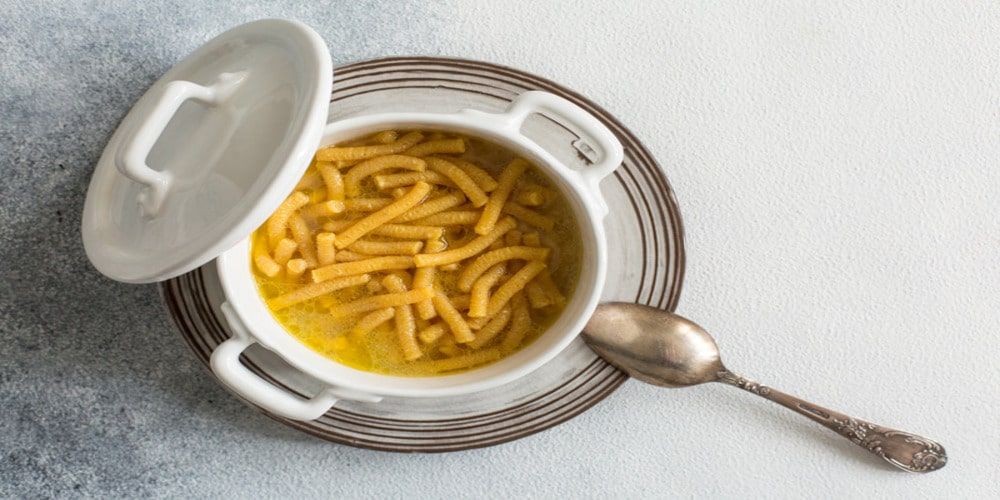
An Emilia Romagna cuisine specialty that is widespread throughout the region is the passatelli, which is often served in broth, as a soup. This is a typical dish from Ravenna, a humble recipe that over time has become a real comfort food that dominates the dinner tables of all Emilians during the winter period.
It is prepared with a mixture of dry breadcrumbs, Parmesan cheese, eggs and flour and is topped with a sprinkling of pepper and a dash of lemon juice, which is then passed through a tool called “fer di pasaden”, very similar to a potato masher, which makes it possible to make narrow worms about 4-5 cm long. Afterwards, they are cooked in meat broth and eaten hot.
There are, however, many dry variants for the warmer seasons, which involve the use of meat or fish sauces, with porcini mushrooms or vegetables, depending on the preferences.
2. Rabbit in porchetta from Rimini
Among the little-known culinary specialties of Emilia Romagna is another second course we want to mention, rabbit in porchetta.
A typical delicacy of Rimini cuisine that is, however, also shared with the neighboring region of Marche, rabbit in porchetta is prepared in a very similar way to its counterpart with pork and is flavored with a mixture of lard, salt, garlic, pepper and wild fennel, wrapped in bacon and later baked in the oven, usually along with a side dish of potatoes.
The special feature of the Rimini version, which makes this dish even tastier, is the marinating with Sangiovese, one of the most popular local wines.
1. Tenerina cake from Ferrara
As in a rich and satisfying lunch, we close our excursus of the Emilia Romagna food specialties with a top dessert, a chocolate triumph that will captivate you with its delicious aroma and melting texture.
Tenerina cake is also known as “montenegrina,” since it was invented to pay homage to Elena Petrovich of Montenegro, beloved wife of King Victor Emmanuel III. The queen was reportedly a very sweet and generous woman, a true philanthropist, and that's why the cake had to somehow reflect her spirit. It is also often referred to as the “lovers' cake” just to recall the very strong feeling that bound the spouses together.
Although its city of origin is Ferrara, where it was first prepared, this cake is easily found in restaurants and pastry shops throughout the region.
It is made with melted dark chocolate, eggs, butter and a few tablespoons of flour, so that the core remains moist and the surface displays a delicate crust. It is often paired with a delicious mascarpone cream.
The Emilia Romagna food specialties: a never-ending journey
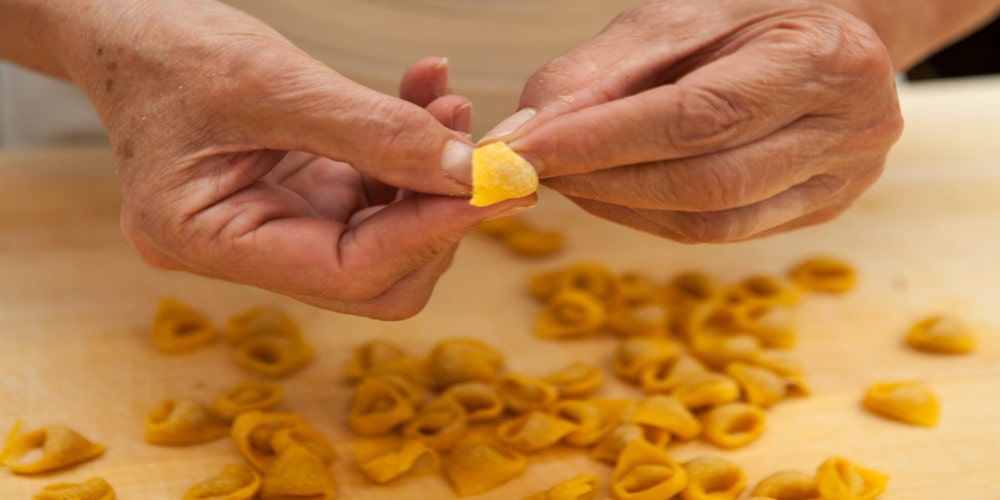
With these 10 Emilia Romagna food specialties, we have outlined a sort of tasty journey through the provinces, listing some very well-known dishes and some that are perhaps a little less famous in the cuisine of this region, but equally delicious.
Both inland and along the coast, however, you can try hundreds of further delights that we recommend you to discover in the taverns, restaurants and why not, in the homes of the Emilians and Romagnolians, who for hospitality, as for skill in the kitchen, are second to none.
About the author
Written on 30/07/2024


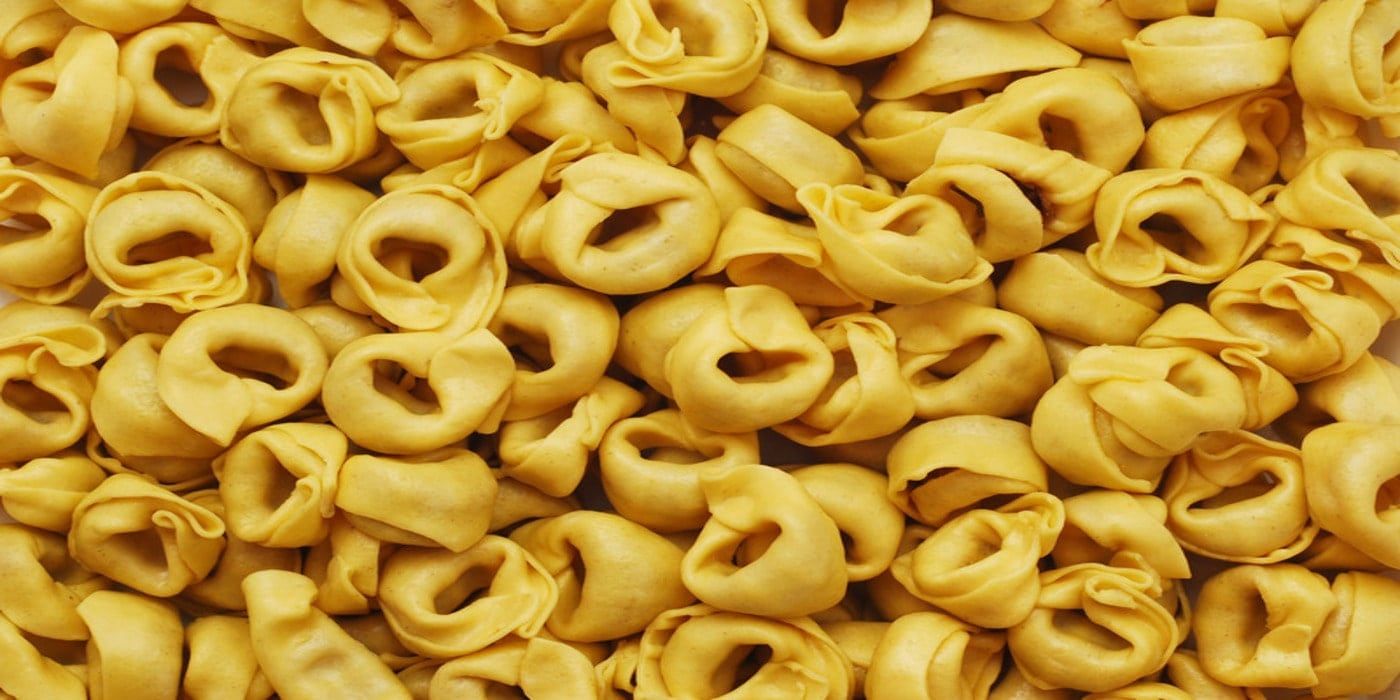
Chiara Spaziano
Let's explore together 10 Emilia Romagna food specialties - a region famous all over the world for its good food